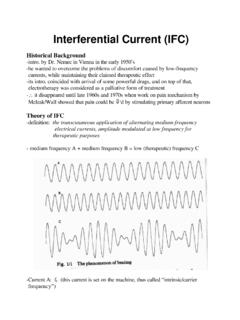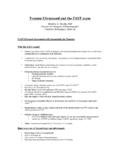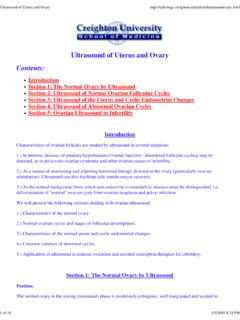Transcription of Ultrasound - Physiomontreal - Resource site for ...
1 Ultrasound Outline What is Ultrasound ? 1. Sound wave physics 2. Sound energy and its effect on soft tissue Pulsed non-thermal Ultrasound enhance tissue healing Cavitation and microstreaming Continuous thermal Ultrasound Contraindication & precautions Clinical judgment and dosage Literature Review with a grain of salt PLEASE!!! WHAT IS Ultrasound ? Ultrasound is a sound wave that has a frequency greater than 20 KHz. It is generated by applying an alternate current to a piezoelectric crystal (found in the transducer in the sound head). This crystal contracts and expands at the same frequency at which current changes polarity. The sound field generated by this crystal in turn makes the molecules in the sound field vibrate and oscillate. The crystal commonly used in US units is synthetic plumbium zirconium titanate (PZT). The quality of the crystal is what makes your US expensive. Crystal quality depends on the following: Beam Nonuniformity ratio: ranges from 2 to 6 the smaller the better.
2 Effective Radiating Area: as close to sound head area as possible Therapeutic Ultrasound has a frequency range of and MHz. Most clinics will have 1 MHz and 3 MHz sound head. Sound wave physics Solids and liquids consist of molecules held together by elastic forces that behave like rubber bands connecting each molecule to each of its nearest neighbors. If one molecule is set in vibration, then it will cause its immediate neighbors to vibrate, and in turn their neighbors, and so on until the vibration has propagated throughout the entire material. This is a wave. A sound wave is sound energy that is transmitted from one molecule to the next. A sound wave cannot travel by itself. It needs a medium for transmission (solid, liquid, gas). Energy contained within a soundbeam is decreased as it travels through tissue. Energy is lost to: Reflection or scattering of the soundbeam when it strikes a reflecting surface Absorption energy lost by the sound wave as it overcomes internal friction that exists in tissue while traveling through it.
3 Higher the frequency, the more rapidly the molecules are forced to move against this friction. The more they move, the more energy is consumed (absorbed); the soundbeam will therefore have less sound energy available to propagate further through the tissue. The velocity of the wave travel depends on the closeness of the molecules of the medium. The closer the molecules, the quicker they collide with each other and sooner they respond to disturbance, the faster they loose energy in a short distance. Energyfinal = Energyinitial (Ereflected + Eabsorbed) So a 3 MHz sound head will affect more superficial tissues while a 1 MHz sound head will affect deeper tissues. Example: Sound travels through air easily and can go far (yelling out in the back yard). Sound can go further because there is little energy loss by absorption. Air molecules are easily compressed. Sound does not travel easily through a brick wall that is denser (someone yells from the outside of the house and you can t hear him from the inside).
4 Brick molecules are a lot closer together, harder to compress. Brick therefore absorbs more of the sound energy going through it. SOUND ENERGY AND EFFECT ON SOFT TISSUE So how does sound wave behave when it travels through human tissues? From the air medium, it must enter the skin/fat which has a significantly higher density. There is 100% reflection of the sound wave at the air-skin interface. If we put a coupling medium such as gel to create a sound head-gel-skin interface, reflection is reduced to only ; the rest of the sound energy will be transmitted through the skin barrier. As noted in the absorption coefficients table, sound energy travels through much of the soft tissue without much absorption until it reaches tissues with high collagen content, namely bone, periosteum, ligaments, capsules, fascia, tendons, and tissue interface (bursa). Ultrasound energy is absorbed mostly in tissues with high collagen content (bone, periosteum, cartilage, ligaments, capsules, tendons, fascia, scar tissue and tissue interface bursa & synovium).
5 Ultrasound at high intensity near bony areas can be detrimental to the periosteum because of high energy accumulation and heating effect on the soft tissue as sound wave hits the bone (transverse or shear wave). What happens to the tissues that absorb sound energy? Sound energy is nonionizing radiation and therefore its use does not impose the hazards, such as cancer production and chromosome breakage, attributed to ionizing radiation. Sound energy has two physiological effects: 1. Enhance inflammatory response and tissue repair 2. Heat soft tissue PULSED NON-THERMAL Ultrasound ENHANCE INFLAMMATORY RESPONSE AND TISSUE REPAIR Ultrasound energy produces a mechanical pressure wave through soft tissue. This pressure wave causes: 1. generation of microscopic bubbles in living tissues 2. Distortion of the cell membrane, influencing ion fluxes and intracellular activity. Three mechanisms of cell membrane distortion: 1.
6 Acoustic streaming 2. Bubble formation 3. Microstreaming Three mechanisms of cell membrane distortion: 1. Acoustic streaming. The compression phase of an Ultrasound wave deforms tissue molecules (cell membrane). This deformation is called radiation force. 2. Bubble formation cavitation. Radiation force affects gas bubbles in the tissue fluids. Under this pressure wave (compression and rarefaction), these bubbles expand and contract which add further stress to cell boundaries. When bubbles expand and contract, without growing to critical size, the activity is called stable cavitation. Unstable cavitation does not occur in therapeutic range (pulsed 20% @ to 3 W/cm2) in normal tissues except in air-filled cavities such as lungs and intestines. 3. Microstreaming. Cavitation sets up eddy currents in the fluid surrounding the vibrating bubbles and the eddy currents in turn exert a twisting and rotational motion on nearby cells.
7 In the vicinity of vibrating gas bubbles intracellular organelles are also subjected to rotational forces and stresses. This microscopic fluid movement is called microstreaming. Bubble activity augments the mechanical effect of a pressure wave. The scale of cavitation depends on the Ultrasound characteristic; bubble growth is limited by low-intensity, high-frequency, and pulsed Ultrasound . Higher frequency means shorter cycle duration, so that the time for bubble growth is restricted. Pulsed Ultrasound restricts the number of successive growth (excessive energy accumulation) and allows the bubble to regain its initial size during the off period. What is the physiological effect of cell membrane destabilization? Cell membrane destabilization results in an increase in the permeability, therefore many molecules travel into the cell, precipitating secondary effects: 1. Increase skin and cell membrane permeability 2. Increase intracellular calcium -- known as second messenger for cell function including protein synthesis 3.
8 Increase mast cell degranulation 4. Increase histamine and chemotactic factor release by granules from mast cells and circulating platelets influences circulation and protein synthesis. 5. Histamine is released by the degranulation of mast cells. The rate at which this occurs is proportional to the intensity. It is possible to form too much histamine at a high intensity which could prolong the inflammation instead of stimulating healing. The inflammatory response may be prolonged with the application of any heat modality in the inflammatory stage. In summary cell membrane destabilization is thought to enhance the inflammatory response from the inflammatory phase ( Days 1- 6) to the proliferative phase (Days 3-20) Refer to chapter 2 in your book. Common use for pulsed non-thermal Ultrasound Facilitate healing in the inflammatory and proliferative phase following soft tissue injury (tendonitis, bursitis, acute soft tissue injuries) Bone healing ( MHz, pulsed 20%, , 20 minutes, daily) CONTINUOUS Ultrasound THERMAL APPLICATION Continuous, high intensity Ultrasound increases the temperature of the soft tissue by: increasing kinetic energy of tissue molecules ( the hands together fast enough will generate heat on your skin) increasing the production of unstable cavitation Ultrasound kinetic energy when absorbed by tissues can also be converted into heat.
9 Unstable cavitation occurs when the bubbles collapse violently under the pressure due to excessive energy accumulation, after growing to critical size. This implosion produces large, brief, local pressure and temperature increase and causes the release of free radicals. Heating tissues between 40-45degrees using Ultrasound has the following physiological effects: Increase the extensibility of soft tissue Decrease the viscosity of fluid elements Decrease pain perception by slowing nerve conduction velocity Increase metabolic rate Increase blood flow which assists in the reduction of swelling Stimulate the immune system Common use for continuous Ultrasound : Prior to stretching at tight structure (tendon, capsule, ligaments, fascia, scar) Pain control in chronic pain Chronic inflammatory conditions CONTRAIDICATION Undiagnosed pain Cancer Active tuberculosis Psoriasis Decreased circulation Infection Pregnancy Central nervous system tissue Joint cement (cannot use continuous mode, but may use pulsed mode 50% or less) Plastic components Pacemakers Thrombophlebitis Uncontrolled bleeding or blood-thinning medication (coumadin) Eyes Reproductive organs Heart PRECAUTIONS Acute inflammation (use non-thermal settings only) Epiphyseal plates (use pulsed, low intensity < ) Decreased sensation (esp.)
10 With thermal US) Over implanted materials metal reflects 90% of incident US plastic respond like periosteum and it absorbs a large % of US generally safe if the sound head is kept moving DOSAGE PARAMETERS Questions to ask yourself: Is there any contraindications? What is my injured and tissue? (muscle, tendon, ligament, bursa, fascia, bone, periosteum, capsule, synovium, cartilage, joint, nerve) What is the nature of the injury : 1. Traumatic (date & event of injury noted for stage of healing) 2. Cumulative Repetitive Trauma (tendonitis/bursitis/strain/sprain) 3. Degenerative (disc disease, chronic tendonitis, arthritis) Is there any inflammation in this tissue? 1. If yes, you would want to consider Ultrasound to enhance the inflammatory response and promote healing. 2. If no, then is this injured tissue short and scarred down? 3. If tissue shortness and scarring is your problem than you can also consider US to heat up the tissue so you can stretch it after to improve flexibility.





